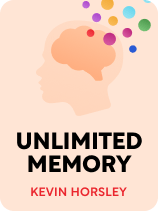

This article is an excerpt from the Shortform book guide to "Unlimited Memory" by Kevin Horsley. Shortform has the world's best summaries and analyses of books you should be reading.
Like this article? Sign up for a free trial here.
What’s an effective association memory technique that anyone can master? How does the SEE method work?
To help you create associations and make any piece of information easier to learn, Unlimited Memory by Kevin Horsley recommends the SEE method. SEE stands for Senses, Exaggeration, and Energize.
Find out how to implement the SEE method into your daily life so you can remember any experience.
The SEE Method
As an association memory technique, the SEE method helps you make information more meaningful, and meaningful information is easier to remember than meaningless information. These three strategies can be used in any order, but Horsley recommends using all three for any piece of important information you want to remember.
Senses: Your five senses are your means of perceiving—and thus learning about—the world. Creating an association between information and your senses automatically makes it more memorable. You can use your senses to make sensory images in your mind that will make information more real and accessible to your brain. For example, say you’re trying to memorize musical terms like forte, allegro, and octave. Forte means strong and loud, and a fort is a strong structure, so create a sensory image by picturing someone standing on top of a fort (visual image) yelling loudly (auditory image) to be heard from the ground.
Exaggeration: As you’re creating your sensory associations, make them ridiculous or illogical to make them stick in your memory better. It’s easier to remember a cat the size of a thimble than a regular-sized cat, for example, or to remember a man with a neon-green mustache than a man with a mustache of a regular color. Returning to our musical terms example: Allegro means fast and lively and sounds like “leg,” so imagine a pair of legs growing comically long, like the size of skyscrapers, so they walk faster.
Energize: Once you have your exaggerated sensory images, animate them. Creating action in your images helps you turn them into a narrative, and it’s easier to remember action than nonaction. To illustrate this, consider our final musical term: octave. Octave means a range of eight notes, and an octopus has eight tentacles, so imagine an octopus animatedly playing a piano and hitting eight notes at once.
| Other Ways to Make Information Memorable In A Mind for Numbers, Barbara Oakley echoes Horsley’s argument that information is easier to recall the more you’re able to connect it to existing information. Also like Horsley, she suggests that relating new information to your senses makes it more memorable, but she also identifies several other factors that make information easier to remember. These factors include: 1) if it involves physically moving your body (this is distinct from Horsley’s Energize tip because his technique relies on a mental image rather than actual movement), 2) if it makes you laugh (you might incorporate this into Horsley’s Exaggeration tip by making your associations so extreme as to make them laughable), 3) if you write it down, 4) if you say it out loud, 5) if you link it to something spatial (which aligns with the next section in our guide, and 6) if it tells a story. Others provide additional support for why turning information into a story makes it more memorable: In Wired for Story, Lisa Cron explains that our brains are neurologically wired to retain information better if it’s told as a story because it helps us understand the world around us and make predictions that could help us survive. If someone could tell us a compelling story about how they escaped danger, we could use that information to avoid a similar danger in the future—provided it was presented in a memorable way. |

———End of Preview———
Like what you just read? Read the rest of the world's best book summary and analysis of Kevin Horsley's "Unlimited Memory" at Shortform.
Here's what you'll find in our full Unlimited Memory summary:
- Why there's no such thing as a bad memory
- How anyone can train their brain to learn and remember anything
- Memory association techniques and how to use them






